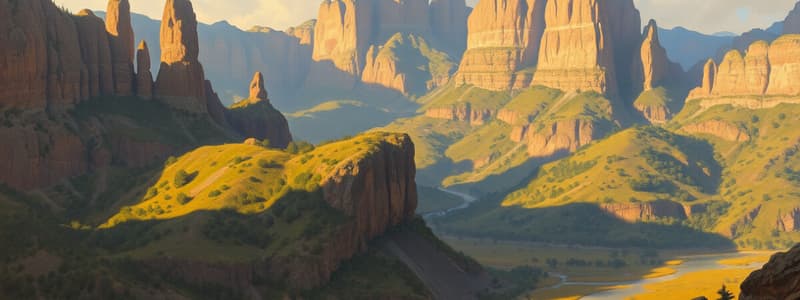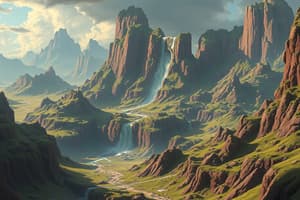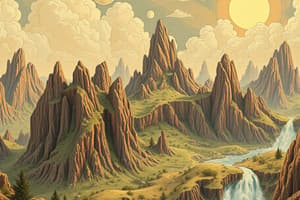Podcast
Questions and Answers
The visible features of the land are called ______.
The visible features of the land are called ______.
landforms
The forces that originate from within the Earth are known as ______ forces.
The forces that originate from within the Earth are known as ______ forces.
endogenic
Mountains can rise at least ______ feet above the surrounding landscape.
Mountains can rise at least ______ feet above the surrounding landscape.
1,000
The Himalayas and the Alps are examples of ______ fold mountains.
The Himalayas and the Alps are examples of ______ fold mountains.
Old fold mountains are generally more than ______ million years old.
Old fold mountains are generally more than ______ million years old.
Exogenic forces include the actions of wind, running water, and ______.
Exogenic forces include the actions of wind, running water, and ______.
A series of mountains that are close together form a ______.
A series of mountains that are close together form a ______.
Fold mountains are formed when the Earth's crust is creased or ______ due to compression.
Fold mountains are formed when the Earth's crust is creased or ______ due to compression.
The Urals, the Appalachians and the Aravallis are examples of old fold ______.
The Urals, the Appalachians and the Aravallis are examples of old fold ______.
Young fold mountains have high conical ______.
Young fold mountains have high conical ______.
Block mountains are also known as ______.
Block mountains are also known as ______.
The rift valley formed due to faulting is known as ______.
The rift valley formed due to faulting is known as ______.
Volcanic mountains are formed when ______ spews out from a crack in the Earth's crust.
Volcanic mountains are formed when ______ spews out from a crack in the Earth's crust.
The Appalachian range in the United States is well-known for coal and ______ deposits.
The Appalachian range in the United States is well-known for coal and ______ deposits.
Perennial rivers from ______ mountains are important sources of water.
Perennial rivers from ______ mountains are important sources of water.
The Himalayas serve as a natural political ______ between India and China.
The Himalayas serve as a natural political ______ between India and China.
Valleys can be found in plains, hills, and ______.
Valleys can be found in plains, hills, and ______.
A river valley is typically ______-shaped with steep walls.
A river valley is typically ______-shaped with steep walls.
Glacial valleys have a contour similar to the shape of a ______.
Glacial valleys have a contour similar to the shape of a ______.
Rift valleys are formed by the movement of ______ plates.
Rift valleys are formed by the movement of ______ plates.
The Grand Canyon in Arizona, USA, is an example of a river ______.
The Grand Canyon in Arizona, USA, is an example of a river ______.
Mountainous countries like Japan and Italy have developed ______ from perennial rivers.
Mountainous countries like Japan and Italy have developed ______ from perennial rivers.
A graben may continue to drop and become the floor of a larger ______ valley.
A graben may continue to drop and become the floor of a larger ______ valley.
The Great Rift Valley is located in eastern ______.
The Great Rift Valley is located in eastern ______.
The Bresse Graben and the Upper Rhine Graben are part of the Cenozoic ______ System.
The Bresse Graben and the Upper Rhine Graben are part of the Cenozoic ______ System.
The Narmada River flows westwards between the Satpura and ______ ranges.
The Narmada River flows westwards between the Satpura and ______ ranges.
Plateaus cover almost ______ per cent of the Earth’s surface.
Plateaus cover almost ______ per cent of the Earth’s surface.
The Deccan Plateau in India is one of the ______ plateaus.
The Deccan Plateau in India is one of the ______ plateaus.
Intermontane plateaus border around fold ______.
Intermontane plateaus border around fold ______.
Piedmont plateaus are situated at the foot of the ______.
Piedmont plateaus are situated at the foot of the ______.
The Plateau of Maharashtra is an example of a continental ______.
The Plateau of Maharashtra is an example of a continental ______.
Dissected plateaus are formed due to intensive ______ and erosion.
Dissected plateaus are formed due to intensive ______ and erosion.
Most of the minerals in the world are found in ______.
Most of the minerals in the world are found in ______.
At the edges of plateaus, rivers form ______ which provide ideal sites for generating hydel-power.
At the edges of plateaus, rivers form ______ which provide ideal sites for generating hydel-power.
Elevated parts of plateaus have a cool climate even in tropical and ______ regions.
Elevated parts of plateaus have a cool climate even in tropical and ______ regions.
Plateaus have large grasslands which are suitable for animal rearing, especially ______, goat and cattle.
Plateaus have large grasslands which are suitable for animal rearing, especially ______, goat and cattle.
Coastal ______ generally rise from sea level until they meet higher landforms.
Coastal ______ generally rise from sea level until they meet higher landforms.
Most of the plains have been formed by the deposition of sediments brought down by ______.
Most of the plains have been formed by the deposition of sediments brought down by ______.
Plains have an average height of less than ______ m.
Plains have an average height of less than ______ m.
Structural plains are characterised by ______ formed from horizontally bedded rocks.
Structural plains are characterised by ______ formed from horizontally bedded rocks.
Alluvial plains are formed by a river depositing ______ on their flood plain or river bed.
Alluvial plains are formed by a river depositing ______ on their flood plain or river bed.
Flood plains are adjacent to a stream, river, lake, or wetland and experience occasional or periodic ______.
Flood plains are adjacent to a stream, river, lake, or wetland and experience occasional or periodic ______.
Erosional plains are formed when an elevated tract of land is worn down to a plain by the process of ______.
Erosional plains are formed when an elevated tract of land is worn down to a plain by the process of ______.
The Indo-Gangetic Plains are large ______ of the Indus and the Ganga-Brahmaputra river systems.
The Indo-Gangetic Plains are large ______ of the Indus and the Ganga-Brahmaputra river systems.
Life in the mountainous terrain is tough due to ______ weather and less suited relief features for agriculture.
Life in the mountainous terrain is tough due to ______ weather and less suited relief features for agriculture.
Houses in the mountainous regions are normally made of ______ to insulate from the cold temperature.
Houses in the mountainous regions are normally made of ______ to insulate from the cold temperature.
In the plains, houses are made of thick ______ and bricks.
In the plains, houses are made of thick ______ and bricks.
The uneven terrain of the mountainous region is not conducive for setting up ______ scale industries.
The uneven terrain of the mountainous region is not conducive for setting up ______ scale industries.
Plains are fertile and easy to cultivate, hence many types of ______ are grown here.
Plains are fertile and easy to cultivate, hence many types of ______ are grown here.
The flat and level lands of the plains have helped in the development of a robust transportation ______.
The flat and level lands of the plains have helped in the development of a robust transportation ______.
In the mountainous regions, people primarily rely on ______ as the main mode of transport.
In the mountainous regions, people primarily rely on ______ as the main mode of transport.
Coastal plains provide an ideal base for establishing industries related to sea ______ and other allied industries.
Coastal plains provide an ideal base for establishing industries related to sea ______ and other allied industries.
Flashcards are hidden until you start studying
Study Notes
Landforms and Their Forces
- Landforms include mountains, plateaus, deserts, and coastal plains, shaped by natural forces over time.
- Endogenic forces originate from within the Earth, causing folding, faulting, earthquakes, and volcanic activity.
- Exogenic forces act on Earth’s surface via wind, water, and glaciers, leading to weathering, erosion, transportation, and deposition.
Mountains
-
Mountains rise at least 1,000 feet above surrounding landscapes, featuring steep sides and peaks.
-
Fold Mountains are formed by the compression of the Earth's crust during tectonic plate collisions.
- Young Fold Mountains (10-25 million years old) include the Himalayas and Rockies, often exhibiting geological activity.
- Old Fold Mountains (over 200 million years old) like the Appalachians show erosion features such as rounded peaks.
-
Block Mountains form when one faulted side shifts upwards, creating uplifted regions, known as horsts, e.g., the Sierra Nevada in the USA.
-
Volcanic Mountains arise from magma ejected during eruptions, forming conical shapes over time, such as Mt. Kilimanjaro and Mt. Fuji.
Importance of Mountains
- Serve as natural resources reserves, providing minerals, timber, and medicinal herbs.
- Perennial rivers from snowy mountains contribute to irrigation and lower valley fertility.
- Act as political boundaries, illustrated by the Himalayas separating India and China.
- Influence local climates by altering weather patterns and supporting tourism, with destinations like Shimla and Nainital attracting visitors.
Valleys
- Valleys are common landforms shaped by the erosion of flowing water or ice.
- River Valleys are V-shaped and formed by water action, with the Grand Canyon as an example.
- Glacial Valleys are U-shaped, created by glaciers scraping the earth.
- Rift Valleys emerge from tectonic plate movements; notable examples include the Great Rift Valley in East Africa.
Plateaus
- Plateaus are elevated, flat areas characterized by steep sides, covering about 18% of Earth's surface.
- Formation involves volcanic activity or erosion over time, producing various types:
- Intermontane Plateaus, like Tibet, are located among mountains.
- Piedmont Plateaus, like the Malwa Plateau, lie at mountain bases.
- Continental Plateaus, such as Maharashtra Plateau, form away from mountains.
Significance of Plateaus
- Rich in minerals, facilitating easier extraction compared to mountains.
- Hydro-power generation potential from waterfalls at plateau edges.
- Support agriculture due to fertile soils, particularly in lava plateaus.
Plains
- Plains are flat, low-lying areas formed mainly by sediment deposition from rivers and other agents.
- Classified as:
- Structural Plains with undisturbed rocks.
- Depositional Plains formed by sediment deposition (e.g., alluvial plains).
- Erosional Plains created by the wearing down of elevated land.
Indo-Gangetic Plains
- Large floodplains of the Indus and Ganga-Brahmaputra rivers, crucial for agriculture and settlements, densely populated due to fertile soil.
Impact of Landforms on Human Life
-
Life in Mountains:
- Sparse population due to tough living conditions and limited agricultural opportunities.
- Houses are typically made of wood with slanting roofs; traditional clothing is warm and thick.
- Economy focus on agriculture, handicrafts, and tourism.
-
Life in Plains:
- High population density facilitated by flat terrain for construction and transport.
- Houses are sturdier, featuring a variety of materials based on climate.
- Agriculture thrives due to fertile soil leading to diverse crop production and industrial opportunities.
-
Transportation: Mountains have limited transport networks, while plains support robust infrastructure due to their level terrain.
Studying That Suits You
Use AI to generate personalized quizzes and flashcards to suit your learning preferences.




